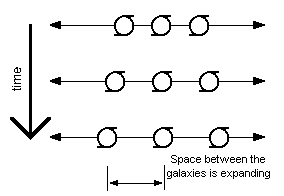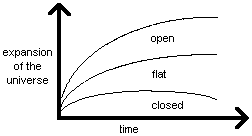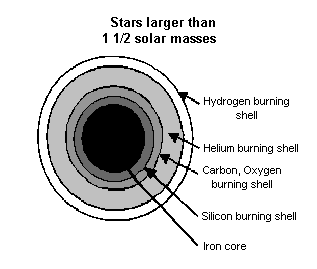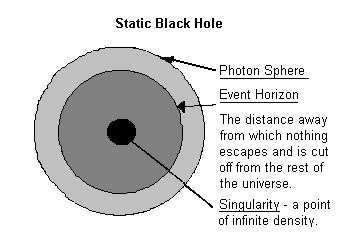

For the third year in a row the University of Michigan’s Department of Physics is hosting Saturday Morning Physics at 10:30 am in the Dennison Hall Auditorium. This year effort is billed as “multimedia presentations for the passionately curious” Well, I don’t know about the passion part, but I loovvvee physics ! Contact U of M Physics at (734) 764-4437 or check out their web site at http://www.lsa.umich.edu/physics/events/saturdaymorningphysics for more information.
This year’s first of three topics is the Fate of the Universe was presented by astrophysicist Dr. Greg Laughlin. Together with his college Fred Adams, also of the U of M, Dr. Laughlin created some press at last winter’s meeting of the American Astronomical Society when they presented their research on the ultimate fate of the cosmos. Using the science that we currently posses Dr. Laughlin explores the evolution of the Universe.
We are asked to make three mental leaps. First, imagine the Earth (dia. 7,500 miles) as a grain of sand and the Sun (dia. 865,000 miles) as a marble. Two meters from the Sun is the Earth in this scale model. Second, then imagine the Sun as a grain of sand centered in Ann Arbor. The nearest grain of sand, I mean star, Alpha Centauri is in Ypsilanti, with the closest bright star Sirius in Dexter. Again, with the Sun as a grain of sand our galaxy, the Milky Way (dia 100,000 light years), would be the size of the Moon’s orbit or about 477,700 miles. Ten billion stars make up the Milky Way. The final mental leap would scale the Milky Way at the size of a 6 inch disk and the nearest significant galaxy Andromeda would be about 11 feet away in this scale model. If this 6 inch model of the Milky Way was placed at the center of Ann Arbor the Universe (dia. 15 billion light years) would be the size of the city (dia. 14 miles). The number of galaxies is approximately equal to the number of stars in our galaxy or about 10 billion ! We can imagine the universe is a very big place by making these three mental leaps.
To look at the cosmos is to look into the past. Our Moon is 1 light second away. The image of the Moon we see is 1 second old because it takes the reflected light of the Moon that long to travel through space and reach our eye. The Sun is 8 light minutes away. The Solar System is several light hours across. Alpha Centauri is 4 1/2 years away if you travel at light speed. The Andromeda galaxy is over 2 million light years away. Stephan’s Quintet, a five galaxy cluster in Pegasus, is 100 million light years away. The Hubble Deep Field view looks into the past of the universe as it appeared 4 1/2 billion years ago or longer that the Earth has existed!
The Astronomer Edwin Hubble discovered what galaxies are and that they are receding from our position in space. This challenged our preferred notion that we are the center of the universe. Hubble showed us that there is nothing special about our galaxy or our position in space. The space between the galaxies is getting further apart and the universe is getting larger with each passing moment. This would imply that at the moment of the Big Bang everything was at the same place and time. The expansion of the universe was confirmed in 1964 by two Bell Lab radio astronomers, Arno Penzias and Robert Wilson, who detected static coming from all directions when measured with a radio horn antenna. This noise was found to be the conformation of cosmic background radiation or light from the Big Bang.

We live in a time of the expansion of the universe. The expansion of the space between the galaxies is the result of the Big Bang. If we throw a ball up into the air gravity tells us that the ball will come down. The same logic suggest that if galaxies are expanding could there be a time in the future were all the galaxies could be receding. Sufficient gravity or mass is need to pull the galaxies back. Cosmologist call this type of universe “closed”. The universe will close back on itself if there is the necessary mass to pull itself back after an initial period of expansion. If insufficient mass is present the universe will expand forever. This is called an “open” universe. A “flat” universe has neither enough mass to close back on itself or expand forever. The long term fate of the universe is determined by how much mass is present.

Dr. Laughlin borrows the method geologist use to divide up past time or eras and uses this tool to divide up future time. Eras are segmented in to cosmological decades defined as Time = 10 to the “n” power. Using a closed universe the speaker presented the fate of this type of universe. “Science tells us what is going to happen” explains Dr. Laughlin. Our time is termed the Stelliferous era, or star-filled era. Written in cosmological decades this is 10 to the 6th to the 14th power. This era is a time were stars are born, live, and die; and life is possible. The Degenerate Era is from cosmological decades 10 to the 15th to 37th power. Stars are extinguished. Left behind are white dwarfs, neutron stars, and black holes. At cosmological decade 38th the Black Hole era begins. At cosmological decade 10 to the 100th power the Dark Era begins as black holes have radiated away all mater and the universe consist of electrons, positrons, neutrinos and radiation.
The long term fate of the Earth is determined by the fate of the Sun. Our Sun is currently on main sequence burning hydrogen in its core. This process uses 4 hydrogen atoms and yields 1 helium atom and releases heat in the process (4H = 1He + energy). The fusion process creates pressure that counters the gravitational pressure on the Sun and keeps it from collapsing in on itself. In five billion years from now the Sun will experience difficulty in supporting itself from the force of gravity as the reduced pressure from burning hydrogen diminishes. As the pressure from gravity increases the temperature in the core will increase. This increased core temperature will cause helium to begin fusing. As the Sun’s helium core heats up the Sun will get bigger, redder, and hotter. Mercury will be consumed by the Sun. Helium will then fuse to create carbon. The Sun will become a red giant and the Earth’s oceans will boil. So much gas will be released from the oceans and surface of the Earth that a run away greenhouse effect will take over our atmosphere. All life on Earth is extinguished. Carbon fuses to oxygen. The Sun’s outer hydrogen burning shell expands outward. Venus’ orbit decays and spirals into the Sun. The Sun becomes a planetary nebula and blows its outer shells into space. When the Hydrogen and helium envelops are cast out into space the Sun becomes a super dense dying star or white dwarf. A cubic foot of white dwarf matter equals 5760 tons. With the Earth as the Sun’s first planet all former signs of life on our planet disappears as the Earth becomes a molten ball of lava.
[intermission; Atwater Pils - en goed damer’s bier; Krausen Dunkel - Salieri’s favorite; K. Hell - bright, three thumbs up !!!; K. Rost - unmemorable]
For stars larger than one and a half solar masses the fate will be somewhat stranger. Instead of fusion stopping at carbon and oxygen; the star continues to fuses heavier elements. Like the shells in an onion larger stars burn hydrogen in its outer layer, then helium, carbon, oxygen, silicon, and finally iron. Iron will no longer permit fusion to take place and the center of the star collapses in on itself. In a brief moment the massive amount of in falling matter recoils on its center and creates a super nova. A star with several solar masses is reduced to a neutron star with the size of the city of Ann Arbor. The density of a neutron star is so immense that even electrons are striped from their atoms so that the core of a neutron star is composed of only neutrons. Stars more massive yet end their lives in super novae that may completely annihilate the star or leave behind a black hole. All over the universe stars are born and dying leaving behind white dwarfs, neutron stars, and black holes.

Most of the stars in the universe are low mass red dwarf stars with masses less than 15% of our Sun. These are the real story of the universe. These stars will far out live more massive stars because they spend their limited energy more wisely. A red dwarf with 10% the mass of the Sun is only 1/10,000 as luminous. As time moves forward these stars become more important. Red dwarf stars will last ten trillion years.
As the Stelliferous era ends, at about cosmological decade 10 to the 14th power, star formation comes to an end. What is left over is white dwarfs, neutron stars, pulsars, black holes, planets and brown dwarfs. Brown dwarfs are failed stars; suns whose masses is thought to be less than 0.08 solar masses. If the planet Jupiter were approximately 10 times bigger it would be a brown dwarf.
If you wait long enough, say 10 to the 19th years, the structure of galaxies will change. solar systems will be striped of their suns through interactions with stars in their vicinity. Approximately 10% of the stars will be sent to the center of the galaxy. The other 90% will be flung out into intergalactic space. Galaxies will dissipate with only their cores remaining.
What happens to the remaining planets and degenerate stars ? Ordinary mater will decay into fundamental particles. More specifically the protons in atoms will decay. The time scale under which proton decay will occur is uncertain; but is thought to occur in 10 to the 35th to 40th years (The Degenerate Era). Physicist using large tanks of pure water have attempted to look for proton decay by observing what amounts to a significantly enormous amount of protons. Eventually proton decay will occur and dramatic changes will occur in the universe. Looking at a white dwarf as an example we see what dramatic change will occur. A white dwarf consist almost of pure carbon. As proton decay occurs the carbon changes into other elements. These objects will eventually become Jupiter like objects, or brown dwarfs. From there the mater will further decay into electrons and gamma particles or pure energy. All mater will decay this way - neutron stars, stars, planets.
What is left over after proton decay? Black holes are what is left over in what in termed the Black Hole Era. A black hole is a place in space were the gravitational mass is so significant that it has literally cut itself off from the universe. Nothing that enters to black hole will ever come out, not even light. We know it takes a significant rocket to blast a space craft to the proper escape velocity so that space craft can leave the surface of the Earth. We can imagine a more significant rocket would be needed to accelerate the same space craft to a much higher velocity to escape a mass of the scale of the Sun. A space craft attempting to escape the surface of a neutron star would have to accelerate to half the speed of light, but the same space craft traveling at light speed will never leave a black hole because there is no escape velocity.

While we can not observe a black hole it is possible to observe the space around a black hole to verify its existence. This is what astronomers did when looking a black hole, named X-1, in the constellation Cygnus. This black hole is thought to have a companion star. The X-1 system is a binary system with the black hole and companion star in orbit around a common center of gravity. The black hole is pulling mater from its companion and this mater rotates about the black hole and forms an accretion disk. X-rays originate from the area just outside the event horizon of the black hole and the presence for the black hole is thought to be confirmed by this process.
Stephen Hawking’s claim to fame is his proof that black holes are not really black. In the vacuum of space pairs of virtual particles, consisting of a partial and antiparticle, come into existence by tiny quantum fluctuations in space. Normally the particle and antiparticle annihilate each other in an instant. If a pair of these particles and antiparticles come into existence adjacent to the event horizon and one of the members is pulled in to the black hole, the other member could escape the black hole because of its relativistic speed provided it is still on our side of the event horizon. One particle gets striped away from the virtual pair and gets sucked into the black hole while the other particle radiates away into space. This is called Hawking radiation.
Black holes come in sizes from stellar to galactic. As the mass of a black hole increases so does its size. A black hole with the mass of the Sun would be a few kilometers in size. A black hole with the mass of the Earth would be the size of a golf ball. In falling antimater from Hawking radiation evaporates away black holes. A black hole the size of a solar mass will decay in 10 to the 65th years. A galactic black hole will decay in 10 to the 100th years. Over an extensive period of time all the black holes in the universe will evaporate and so ends the Black Hole Era.
The fate of the universe ends in the Dark Era. The universe now consist of a sea of elementary particle - electrons,
positrons, neutrinos, and photons. The universe has become dark. The average distance between each individual
particle is as big as our current universe. Very interesting atoms could form strange chemistry in this environment.
The Copernican principle states that the Earth occupies no special place in space. Postulating on a Copernican
Time Principle indicates that the current cosmological epoch has no special significance. Dr. Laughlin believes
interesting processes will occur in the future despite increasingly lower levels of energy available.
[Note: Dr. Laughlin is one of the authors of a book that covers these ideas in more detail: See Adams, Fred and
Laughlin, Greg. 1999. The Five Ages of the Universe: Inside the Physics of Eternity. New York: The Free
Press (A Division of Simon & Schuster, Inc.)].